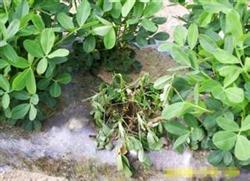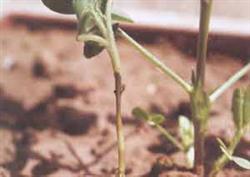Four points should be grasped in the late stage of high yield of peanuts.

Peanut from 50% of the plants appeared full to most pods mature and harvested as its late growth stage. The growth characteristics of this period are as follows: the vegetative growth gradually declined and stopped, the pods became full gradually, and the increased fruit weight generally accounted for 500%-70% of the total fruit weight, which was the main period for the formation of pod yield. The technical measures of field management in this period are as follows: first, extra-root fertilization to protect the top leaf. The absorption of nitrogen, phosphorus and potassium in the late growth stage of peanut accounted for 6.3%, 5.3% and 0.75% of the total absorption during the whole growth period, respectively. Although peanut needed less nutrients during this period, it had a great impact on the formation of yield and the improvement of pod plumpness. The absorption capacity of peanut roots decreased in the later stage, and in order to make up for the lack of fertilizer supply, from the late pod-setting stage, 1%-2% urea and 2%-3% calcium superphosphate aqueous solution were sprayed 2-3 times every 7-10 days, 50 kg per mu each time, in order to prolong the functional period of the top leaf and improve the fullness rate of pods. Second, watering and satiating the fruit in case of drought. In the later stage of peanut growth, the suitable soil moisture is 50%-60% of the maximum field capacity. In this period, if drought occurs, the root system is prone to decline, and quickly cause top leaf shedding, stem and branch withering, reducing full fruit rate, resulting in reduced yield. Therefore, when the soil moisture is less than 40%, it should be watered immediately to protect the roots and leaves, improve the satiety rate, and irrigate in small ditches or sprinklers when watering, and avoid flooding. Third, timely drainage and prevention of rotten fruit. In the later stage of peanut growth, if there is too much autumn rain and poor drainage, it is easy to cause root rot, and when it is serious, the pods will rot or sprout. Therefore, when there are too many Rain Water in the later growth period, the ditches should be dredged in time to eliminate stagnant water and waterlogging in order to ensure high quality and high yield. Fourth, control leaf spot disease and grubs. The main disease in the late growth stage of peanut is leaf spot, the peak of which is 20-30 days before harvest, and the occurrence of high temperature and humidity or continuous overcast and rain is serious. You can choose 75% chlorothalonil wettable powder 600x liquid or 70% methyl thiophanate wettable powder 1000 times liquid spray control, spray once every 10 to 15 days, even 2 times for 3 times. For serious grub fields, 50% phoxim EC 1500 times liquid can be used for heap control, with 50 grams of medicine solution per hole, and the control effect of watering is better after irrigation. In addition, should pay special attention to, peanuts are oil crops, in the prevention and control of grubs, it is strictly prohibited to use 3911, methamidophos, 1605 and other highly toxic pesticides, so as not to affect human health.
- Prev

How to control peanut bacterial wilt
The period of peanut flowering and needle dropping is the outbreak period of peanut bacterial wilt, during this period, attention should be paid to spray control. Control method: when peanuts begin to show buds, spray 1500 times 70% carbendazim solution or 600 times 20% thiophanate copper solution on the leaves every 10 to 15 days, and spray all leaves evenly to begin to have water droplets.
- Next

Control of Peanut sheath Blight
Peanut sheath blight generally began to occur in the first and middle of June. Comprehensive control measures are as follows: ditches should be opened for lower fields in order to remove stagnant water and lower water level, and peanuts on sloping land should also be ditched so that there is no stagnant water after rain. Increase the application of calcium and potassium fertilizer. After the initial flowering stage, combined with accumulated soil to cultivate the bed, 40% lime per mu is applied.
Related
- The first cup of black tea in spring, the flavor and history of tea gardens in Kenya, Africa
- The computer can not only choose potatoes, but also grow tea rice. AI will grow winter oolong tea champion.
- It is not only the inflated tea bitten by insects, but also engraved with the four seasons tea in Beipu.
- The Oriental Beauty Tea Festival in Zhuxian County takes the stage at the weekend to experience the plus-size feast of oil tea.
- & quot; Oriental Beauty Tea & Exploration of Emei in Hsinchu, the hometown of quot;
- The new variety of strawberry "Tainong 1" dessert is the first choice with mellow aroma. Crimson gorgeous
- History of Tea in Taiwan: from Wild Inner Mountain to Export Tea Garden
- Two types of Taiwan Oriental Beauty Black Tea won the British three-Star Award for Childhood Tea Xiang Zhang Jiaqi changed from pilot to champion tea maker.
- Banana species and varieties: the planting history of Taiwan Xianren banana and dwarf banana is long, is banana disease resistant?
- Coffee planting Technology: Qianjie Coffee from Seedling to harvesting

